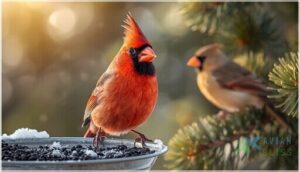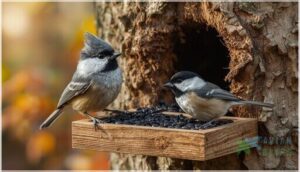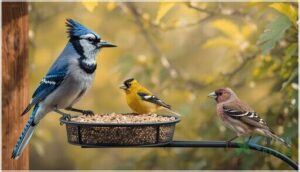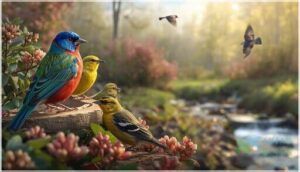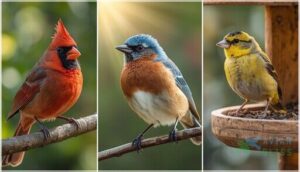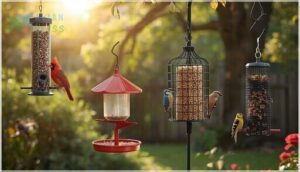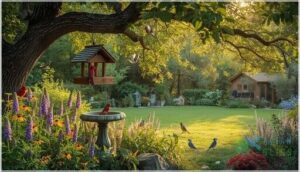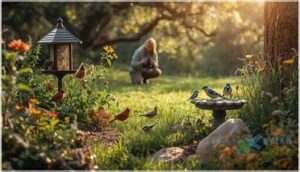This site is supported by our readers. We may earn a commission, at no cost to you, if you purchase through links.
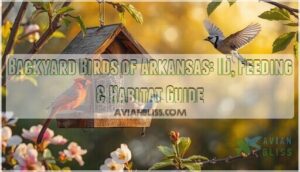
Arkansas backyards host more than 100 bird species throughout the year, with Northern Cardinals, Blue Jays, and Tufted Titmice showing up at feeders across the state. House Finches appear at 96% of feeders, while black oil sunflower seed draws in nearly two-thirds of all feeder visitors.
Your yard’s location, native plants, and feeder setup determine which species you’ll see and how often they’ll visit.
Some birds stick around year-round, singing the same songs your grandparents heard decades ago. Others pass through during migration, stopping just long enough to refuel before continuing their journey north or south.
Table Of Contents
- Key Takeaways
- Common Backyard Birds in Arkansas
- Bird Identification Tips and Features
- Bird Feeding and Feeder Preferences
- Creating a Bird-Friendly Backyard
- Seasonal Bird Activity and Migration
- Supporting Bird Conservation in Arkansas
- Frequently Asked Questions (FAQs)
- What are the most common birds in Arkansas?
- How can I identify a bird in my yard?
- What is the most common backyard bird?
- What birds are migrating through Arkansas now?
- What types of bird feeders attract woodpeckers?
- How do seasonal changes affect bird diets?
- Which Arkansas birds are nocturnal?
- What is the lifespan of backyard birds?
- How do birds communicate in the wild?
- What bird species in Arkansas are endangered?
- Conclusion
Key Takeaways
- Arkansas backyards host over 100 bird species year-round, with Northern Cardinals appearing at 100% of feeders and House Finches at 96%, making black oil sunflower seed your most effective feeding choice since it attracts nearly two-thirds of all visitors.
- You’ll see dramatic seasonal shifts in bird activity—American Goldfinches transform from bright yellow to dull brown each fall, while peak spring migration hits early May with 2.1 billion birds following the Mississippi Flyway through Arkansas.
- Native plants create measurable conservation impact by doubling insectivorous bird nesting rates and tripling chickadee breeding in yards with 70% native coverage, while cutting pesticide use by 70% and water consumption by 60%.
- Your feeder setup directly shapes which species visit, with tube feeders attracting 80% of small seed-eaters like goldfinches, platform designs supporting cardinals and larger birds, and proper placement 10-12 feet from shrubs reducing predator risk while preventing window collisions.
Common Backyard Birds in Arkansas
Arkansas backyards host a vibrant mix of year-round residents and seasonal visitors, from the striking red Northern Cardinal to the tiny Carolina Chickadee.
You’ll likely spot more than 36 different species at your feeders throughout the year, with some showing up daily and others making brief appearances during migration.
Let’s look at the most common birds you can expect to see and how to identify each one.
Northern Cardinal Identification
You’ll spot the Northern Cardinal at nearly every Arkansas feeder—it’s unmistakable. Males show vivid crimson plumage patterns and a sharp black mask, while females wear soft tan-brown feather colors with reddish wing highlights. Both share these traits:
- Prominent crest and thick orange beak shapes
- Clear “birdie, birdie, birdie” song variations
- Year-round residents with nesting habits in dense shrubs
This bird species identification comes naturally with practice. The Northern Cardinal’s feeding behavior is characterized by visits to bird feeding stations that offer sunflower seeds.
Tufted Titmouse and Carolina Chickadee
Two silver-gray regulars team up at your Arkansas feeders year-round—the Tufted Titmouse and Carolina Chickadee. You’ll recognize the titmouse by its jaunty crest and large black eyes, while the chickadee sports a black cap and white cheeks. Both species form mixed flocks that boost foraging behavior and solve feeder puzzles faster together. The titmouse’s nesting habits involve using a tree cavity site for breeding purposes.
| Feature | Tufted Titmouse | Carolina Chickadee |
|---|---|---|
| Size | 5.5–6.3 inches | 3.9–4.7 inches |
| Plumage | Gray crest, pale underparts | Black cap, white cheeks |
| Habitat Preferences | Deciduous woods, gardens | Forest edges, backyards |
| Nesting Habits | Cavity nester, 5–7 eggs | Excavates cavities, 2–25 ft high |
| Social Interactions | Mixed-species flocks | Joins titmouse groups |
Their habitat preferences overlap in suburban Arkansas landscapes. Both favor sunflower seeds and suet at your platform feeders, with group sizes averaging 2–4 birds. These backyard birds compete for nest cavities but cooperate during winter foraging, making bird identification straightforward once you note size differences. Migration patterns? Neither species migrates—you’ll enjoy them all year.
Blue Jay, American Goldfinch, and House Finch
Blue Jay behavior at Arkansas feeders includes noisy visits and caching food in their throat sacks.
House Finches appear at 96% of state feeders in groups averaging 2.9 birds, often outcompeting goldfinches during winter months.
American Goldfinch migration varies by region—northern Arkansas hosts them year-round, while southern populations depart by Mother’s Day. Goldfinch coloration shifts dramatically: males turn vivid yellow in March.
Eastern Bluebird, American Robin, and Carolina Wren
Eastern Bluebird populations in Arkansas have grown 1% annually thanks to conservation efforts like nest boxes. You’ll recognize their bright blue and orange coloring year-round.
American Robins stay through winter in flocks, feeding on berries—they’re not migratory markers as often assumed.
Carolina Wrens are permanent residents, breeding from mid-February through August, with populations increasing 2.4% annually. Watch for their dome-shaped nests in yard cavities.
Seasonal Visitors and Rare Backyard Species
Beyond Arkansas’s year-round residents, seasonal visitors bring considerable diversity. American Goldfinches rank first in winter checklists, while spring migrants showcase stunning arrivals:
- Dark-eyed Juncos forage near feeders from Canada and Alaska
- Painted Buntings peak in May suburban areas
- Indigo Buntings appear late April through early May
- Prothonotary Warblers visit backyard streams May–July
- Swallow-tailed Kites remain rare summer sightings
Migration patterns span 3,000 miles through Arkansas’s critical stopover habitat.
Bird Identification Tips and Features
Spotting birds in your backyard gets easier once you know what to look for. You don’t need to be an expert—just a few key details like color, size, and behavior can point you in the right direction.
Here’s what to focus on when you’re trying to figure out who’s visiting your feeder.
Plumage Colors and Markings
When you’re identifying backyard birds, plumage becomes your most reliable tool. Color variation between males and females—species dimorphism—helps you distinguish House Finch males’ red throats from females’ brown streaking.
Seasonal plumage shifts matter too; American Goldfinches transform from bright yellow to winter brown. Juvenile markings fade as birds mature, and feather coloration reveals age.
These identifying features, combined with regional differences, make bird plumage your field guide.
Bird Size, Shape, and Crests
In your backyard, size identification separates the 9-11 inch American Robin from the tiny 3.8-inch Ruby-throated Hummingbird. Body proportions matter—Carolina Chickadees show large heads on small frames, while Mourning Doves display plump, sleek shapes.
Crest variations distinguish species instantly; Northern Cardinals, Tufted Titmice, and Blue Jays all sport pointed crests.
These shape adaptations reflect feeding habits, with over 50% of Arkansas backyard bird species showing distinctive structural features in statistical occurrence data.
Song, Calls, and Behavioral Clues
You’ll recognize birds faster by listening than looking—Northern Cardinals sing up to 24 distinct “cheer, cheer, cheer” variations, while Mockingbirds showcase vocal mimicry with 150+ sounds mimicking other species. Alarm variations matter too; chickadees add 30-100% more “dee” notes when serious threats appear.
Watch for territorial songs and foraging behavior—Blue Jays dominate feeders in 88% of encounters. Seasonal vocalizations peak during breeding, with dawn choruses increasing 250-300% in spring.
Male Vs. Female Identification
Male and female bird identification in Arkansas relies on plumage differences—male Northern Cardinals flash vibrant red while females show pale brown with red tinges. Size variation helps too; male bluebirds measure slightly smaller than females.
Behavioral cues like feeder dominance and vocal distinctions matter—males sing “peter, peter,” females use different calls.
Juvenile ID gets tricky since young birds start with black bills before developing adult coloring.
Bird Feeding and Feeder Preferences
If you want to bring more birds into your yard, the right feeders and food make all the difference. Different species have distinct preferences—from the type of feeder they’ll visit to what they like to eat.
Let’s look at how you can set up feeding stations that attract the birds you’re hoping to see.
Best Bird Feeder Types for Arkansas
You’ll want feeders designed for Arkansas backyard birds that minimize seed waste and offer squirrel resistance. Tube feeders attract 80% of small seed-eaters like goldfinches, while platform designs support cardinals and larger species. Suet cages bring in woodpeckers year-round.
Proper feeder placement, material durability, and cleaning frequency directly impact bird feeding success and bird watching enjoyment statewide.
Seed, Suet, Fruit, and Nut Options
Black oil sunflower seed attracts 62.9% of feeder species across Arkansas, making it your most reliable wild bird seed choice. Hulled sunflower reaches 88.8% of backyard visitors, while suet types like peanut-flavored blocks bring in woodpeckers and wrens during winter.
Fruit offerings—serviceberries, dogwood, sumac—fuel migration. Nut feeders with unsalted peanuts support nuthatches and titmice.
Seed diversity directly shapes bird feeding success and species richness at your feeders.
Feeder Placement and Safety
Position your bird feeders 10–12 feet from shrubs—close enough for quick escapes, far enough to limit predator ambushes. Mount them 5–6 feet high with cone baffles for squirrel deterrence and disease prevention through reduced ground contact.
Place feeders within 3 feet of windows to cut collision risk, or beyond 16 feet if that’s not possible. Proper feeder height and baffle installation protect both birds and your backyard birdwatching investment.
Visitation Rates and Feeder Habits
Now that your feeders are set up safely, you’ll want to know who’s showing up. Northern Cardinals visit 100% of Arkansas bird feeders, averaging 2.6 birds per visit. House Finches appear at 96% of feeders in groups of 2.9, while Dark-eyed Juncos visit 92% with smaller flocks.
Peak visitation occurs from November through February when natural bird food sources are scarce. Here’s what drives feeder traffic:
- Cardinals favor hopper and platform feeders with black oil sunflower seed
- House Finches flock to tube feeders offering hulled sunflower and safflower
- Pine Siskins arrive in groups of 6.8 birds at 62% of feeders for nyjer seed
- Red-winged Blackbirds prefer ground feeding in flocks averaging 4.6 individuals
- European Starlings form groups of 6 at 44% of backyard feeding stations
Flock composition shifts with seasonal changes. Winter months bring larger groups of sparrows and finches as bird feeding habits adapt to food scarcity. Platform feeders increase diversity, while tube feeders attract smaller seed-eating species. Your birdseed choices directly influence which species visit—black oil sunflower draws the widest variety, making it essential for successful bird watching in Arkansas backyards.
Creating a Bird-Friendly Backyard
Turning your backyard into a haven for Arkansas birds doesn’t require a complete overhaul. A few thoughtful changes can make your space more inviting and support healthy bird populations throughout the year.
Here’s what you can do to create an environment where birds will thrive.
Planting Native Trees and Shrubs
Native Plant Selection transforms your yard into a thriving bird sanctuary. Arkansas’s native trees and shrubs support over 96% of local species—think black cherry hosting 448 moth varieties or red buckeye drawing hummingbirds. You’ll create authentic Habitat Creation through strategic Arkansas Native Plants for Birds choices.
| Species | Bird Benefits | Seasonal Interest |
|---|---|---|
| Red buckeye | Hummingbird nectar, berry feeders | Spring flowers, summer fruit |
| New Jersey tea | Finch seeds, dense cover | White blooms, persistent seeds |
| Black willow | Insect-rich bark, nesting material | Year-round foraging |
| Eastern red cedar | Cedar waxwing fruit, shelter | Evergreen cover, winter berries |
| Hop hornbeam | Cavity nesters, insectivores | Spring catkins, fall seeds |
Planting Native Vegetation delivers Conservation Impact you can measure: insectivorous birds nest twice as often where native shrubs dominate, and chickadee breeding jumps 3.2-fold in yards with 70% native coverage.
Native vegetation doubles insectivorous bird nesting and triples chickadee breeding in Arkansas yards with 70% native coverage
These Ecosystem Benefits extend beyond birds—you’ll slash pesticide use by 70% while reducing water consumption up to 60%. Bird Friendly Backyard Design means clustering at least three different native shrub species, boosting pollinator and bird visits by 40%. Gardening and Landscaping for Birds works best when you select plants offering Seasonal Blooms, shelter, and insect abundance throughout the year.
Providing Water Sources and Birdbaths
During summer droughts in Arkansas, birdbath visits by backyard birds like Blue Jays and Northern Cardinals can triple. Seasonal impact matters: maintain water hygiene with weekly scrubbing to prevent disease during peak birdwatching months.
You’ll see 50% more species when you offer clean water—shallow designs (1–2 inches deep) placed near shrubs work best. Moving water attracts twice as many visitors.
Installing Birdhouses and Nest Boxes
Beyond feeders and birdbaths, birdhouses boost Arkansas cavity-nesting species like Eastern Bluebirds and Carolina Chickadees. Entrance hole size matters—1.5 inches suits bluebirds while chickadees need 1.25 inches. Cedar and untreated pine resist weather best.
- Mount boxes 4–6 feet high on metal posts with predator guards to deter squirrels
- Face entrances southeast for morning warmth and wind protection
- Clean boxes seasonally to prevent mites and encourage re-nesting
Minimizing Pesticide Use and Offering Cover
IPM strategies keep your Arkansas backyard birds safe while controlling pests. Native coverage above 50% multiplies chickadee broods by 2.4 times. Seasonal application timing—early morning or evening—cuts bird exposure risks by 40%.
Native plants like goldenrod and milkweed reduce mortality while providing layered cover from predators. You’ll see richer bird diversity within three years of pesticide-free wildlife habitat management.
| Natural pest-control method | Impact on backyard birds |
|---|---|
| Companion planting (marigolds) | Zero toxicity exposure |
| Beneficial insects introduced | 60% less pesticide reliance |
| Physical barriers (mesh) | 30% chemical reduction |
| Homemade garlic/pepper sprays | Non-toxic to all wildlife |
Seasonal Bird Activity and Migration
Your backyard transforms throughout the year as different birds come and go with the seasons. Some species stick around all twelve months, while others migrate through Arkansas during specific windows of time. Understanding these patterns helps you know what to expect at your feeders and when to watch for new arrivals.
Year-Round Resident Birds
About thirty bird species call Arkansas backyards home all year. Northern Cardinals top your feeder counts with 100% residency, showing impressive population stability and winter survival.
Tufted Titmice, Carolina Chickadees, and Blue Jays form backyard flocks of two to six individuals throughout every season.
These resident birds have mastered urban adaptation, with consistent breeding habits and reliable bird identification patterns that make bird feeding rewarding across all Arkansas habitat types.
Migratory Patterns and Timings
You’ll spot spring migration beginning mid-March in Arkansas, with peak bird movement hitting early May as 2.1 billion birds follow Mississippi Flyway dynamics through the state. Migration triggers vary by species: ruby-throated hummingbirds arrive mid-March from Central America, while fall migration starts July through November.
Climate impacts are shifting seasonal bird sightings—warmer winters now delay duck arrivals, affecting traditional Arkansas bird species timelines.
Attracting Spring and Summer Visitors
You can transform your yard into a magnet for summer resident birds of Arkansas by offering what they need most. Attracting backyard birds during peak season means targeting their nesting and feeding priorities:
- Native plants like milkweed and mountain mints host insects that painted buntings and tanagers hunt for their young
- Water features with shallow areas draw bluebirds and goldfinches, especially during Arkansas’s hot spells
- Nest boxes positioned in sheltered spots attract chickadees and wrens throughout breeding season
Combine diverse feeder types with seasonal food to boost spring visits.
Seasonal Changes in Bird Plumage
You’ll notice American goldfinches shift from vibrant yellow breeding colors to dull olive-brown each fall—that’s their annual molt at work. Most Arkansas backyard birds undergo one complete molt after nesting season, usually late summer through early fall. This camouflage change helps them survive winter while replacing worn feathers for better insulation.
| Species | Breeding Plumage | Non-Breeding Change |
|---|---|---|
| American Goldfinch | Bright yellow males | Dull olive-brown tones |
| Northern Cardinal | Vibrant red year-round | Temporarily ragged during molt |
| Painted Bunting | Males multicolored (year 2+) | Females/young males stay green |
| Wood Duck | Striking breeding colors | Drab eclipse plumage in summer |
| House Finch | Red or orange hues | Muted, less vibrant post-molt |
Seasonal dimorphism becomes obvious when male goldfinches and house finches lose their showiest colors outside breeding season, making them harder to distinguish from females at your feeder.
Supporting Bird Conservation in Arkansas
You’ve probably noticed how many birds visit your backyard—now you can help protect them for the long haul. Conservation isn’t just for scientists or park rangers; everyday birdwatchers play a key role in tracking populations and preserving habitats.
Here’s how you can get involved and make a real difference for Arkansas birds.
Citizen Science and Birdwatching Programs
Contributing to citizen science projects like the Great Backyard Bird Count gives you a real way to help bird conservation. You can join local birdwatching groups or use online birding communities to share observations through state wildlife agencies’ portals.
Program accessibility means just 15 minutes of watching creates measurable outcomes—your data contribution informs habitat protection decisions and educational programs statewide.
Community Conservation Efforts
Beyond backyard feeders, you can support statewide wildlife conservation efforts through hands-on programs. Arkansas Audubon Society partners with ranchers, schools, and restoration projects to expand bird-friendly habitats across the state.
Here’s how community stewardship programs make a difference:
- Ranching initiatives certify sustainable grassland management practices
- School programs introduce thousands of students to habitat conservation
- Habitat restoration projects reconnect critical migratory corridors through population monitoring
Protecting Local Bird Habitats
Habitat fragmentation and invasive species threaten Arkansas backyard birds more than you might realize. Climate change is shifting ranges, while feral cats kill billions of birds nationwide.
Landowner incentives—up to $95 per acre—help restore wetlands and grasslands. Restoration programs have already stabilized over 2,000 yards of streambank habitat.
You can protect local habitats by supporting native plants and reducing pesticides in your own yard.
Economic and Ecological Benefits of Birds
Bird conservation in Arkansas unlocks real value you can measure. Pest control from backyard birds cuts chemical costs by eating crop-damaging insects. Seed dispersal and flower pollination sustain native plants and boost garden yields.
Waterfowl hunting alone generates over $1 million daily during the season, while birdwatching tourism strengthens ecotourism impact.
Property values rise in bird-friendly neighborhoods, proving ecological balance delivers economic returns.
Frequently Asked Questions (FAQs)
What are the most common birds in Arkansas?
You’ll spot Northern Cardinals, Blue Jays, and American Goldfinches at nearly every Arkansas feeder. Tufted Titmice, Carolina Chickadees, and Carolina Wrens round out the state’s most reliable backyard visitors year-round.
How can I identify a bird in my yard?
Start with visual identification—notice plumage colors, size, and distinctive markings. Listen for songs and calls as auditory cues. Behavioral patterns help too.
Field guides and apps offer Arkansas bird identification support with reasonable accuracy.
What is the most common backyard bird?
You’ll see bright red flashes at over half of Arkansas feeders—that’s the Northern Cardinal.
House Sparrows edge ahead in feeder frequency at 54%, though both species show impressive population stability across citizen science surveys.
What birds are migrating through Arkansas now?
Right now, late autumn brings peak migration through Arkansas. You’ll see a massive duck influx along eastern wetlands, lingering hummingbirds, and pelicans following the Arkansas River. Habitat hotspots fill with diverse bird species.
What types of bird feeders attract woodpeckers?
Woodpeckers treat suet feeders with tail props like familiar tree bark, clinging 34% longer than at basic cages.
Peanut feeders and open tube designs loaded with sunflower hearts also draw multiple species effectively.
How do seasonal changes affect bird diets?
Bird diets shift with seasonal bird activity cycles. Winter food scarcity drives reliance on seeds and suet. Spring insect abundance fuels breeding. Summer fruit reliance increases. Autumn migration fueling requires energy-dense foods, while climate diet impacts alter traditional patterns.
Which Arkansas birds are nocturnal?
After dark, Arkansas transforms into hunting grounds for owls. Barred Owls lead with nearly 1,000 yearly sightings, followed by Great Horned Owls. Night herons forage wetlands while mockingbirds sing moonlit serenades.
What is the lifespan of backyard birds?
Most backyard birds live 3 to 6 years in the wild, though some species like Blue Jays and American Robins can reach 14 to 15 years under ideal conditions with abundant resources.
How do birds communicate in the wild?
You’ll notice wild birds rely on acoustic signals, visual displays, and body language to communicate.
Bird songs and calls serve specific purposes—territorial claims, mating rituals, and alarm warnings—while interspecies learning helps different species understand each other’s vocalizations.
What bird species in Arkansas are endangered?
Several Arkansas species face serious threats. The ivory-billed woodpecker remains critically endangered, with no confirmed sightings since the early 2000s.
Red-cockaded woodpeckers, grassland birds like northern bobwhite, and wetland specialists including prothonotary warblers show significant population decline due to habitat loss.
Conclusion
Some birdwatchers claim feeders make birds lazy, but research shows they supplement natural foraging rather than replace it. Your efforts with native plants, clean water, and thoughtful feeding stations create essential stopover points for backyard birds of Arkansas, especially during harsh weather and migration.
These birds don’t depend on your feeders—they choose them. By understanding their needs and adapting your space, you’re not just watching birds. You’re giving them real reasons to stay.
- https://en.wikipedia.org/wiki/List_of_birds_of_Arkansas
- https://birdwatchingcentral.com/backyard-birds-in-arkansas/
- https://avianreport.com/arkansas-backyard-feeder-birds/
- https://www.uaex.uada.edu/counties/white/news/horticulture/Hummingbird_Migration_Through_Arkansas.aspx
- https://delta.audubon.org/news/bluebird-makes-dramatic-comeback-arkansas

